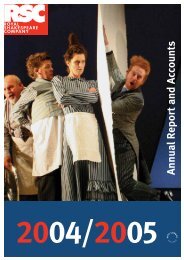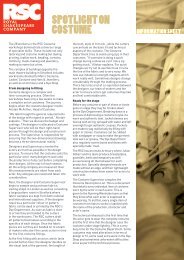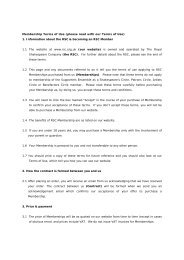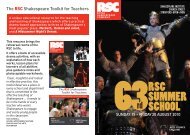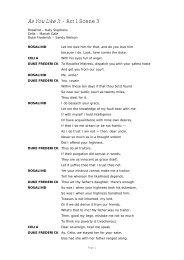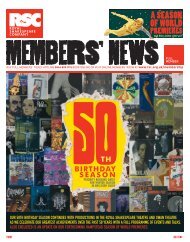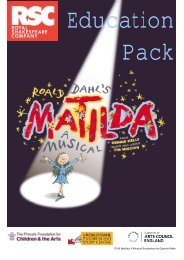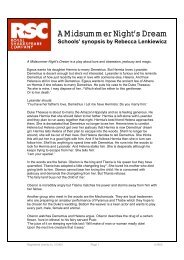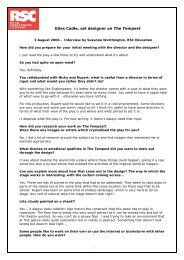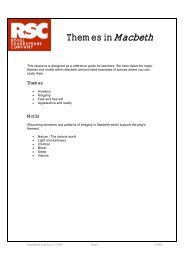THE TAMING SHREW - Royal Shakespeare Company
THE TAMING SHREW - Royal Shakespeare Company
THE TAMING SHREW - Royal Shakespeare Company
You also want an ePaper? Increase the reach of your titles
YUMPU automatically turns print PDFs into web optimized ePapers that Google loves.
EXPLORING <strong>THE</strong> CHARACTERS<br />
This activity can be used alone or as an extension of the exercise sequence described in the<br />
teachers’ pack for the 2011 Young People’s <strong>Shakespeare</strong> production of The Taming of the<br />
Shrew. The pack is available on this webpage: www.rsc.org.uk/education/resources<br />
(Download the pack and read the description on page 6 of the active approach to exploring<br />
character in this play.)<br />
<strong>Shakespeare</strong> wrote for a bare thrust stage, with only the<br />
theatre architecture, some carefully selected props and a<br />
few bits of costume to provide all the stage design. This<br />
was ‘actor’s theatre’ with the actor carrying the great<br />
majority of responsibility for the success of the show.<br />
The 2012 production of Shrew is also performed on a thrust<br />
stage and while there is more in the way of stage set than<br />
in <strong>Shakespeare</strong>’s time, the properties, or ‘props’, are still<br />
very powerful on a comparatively plain set and give the<br />
audience important information about the characters.<br />
Personal props are especially useful for creating vivid<br />
characters. In this production, for example, in the first two<br />
acts, Kate is seldom without a cigarette and a drink.<br />
Playing with props<br />
Lisa Dillon as Kate in the 2012 production<br />
To prepare, write the names of the Shrew characters on slips of paper and put them in a<br />
hat/container.<br />
Ask students work solo or in pairs. Each person or pair picks a character from the hat.<br />
Explain to them about the story-telling power of props, especially on a thrust stage (see<br />
above). If possible project the picture above and others from the photo galleries of the<br />
1976 and 2008 productions, available in our Resource Bank:<br />
www.rsc.org.uk/education/resources/bank/the-taming-of-the-shrew/images/<br />
Have students draw a prop taking up about half of one side of A4 which they feel would<br />
give important information to the audience about the character they have chosen and<br />
which would also help the actor in creating the role.<br />
Specify that it must be something the character can use in at least one scene in the play.<br />
Ask the students to write their name at the top of the paper. Then pass the papers<br />
around the class. As other students receive them, ask them to guess which character the<br />
prop is for, and write that character’s name below or beside the drawing.<br />
If possible, and if you have time, ask students to bring in equivalents for the props they have<br />
drawn or provide them from the school’s property store. Then:<br />
Ask students to move around the space using these props as they believe their character<br />
would. When they encounter another character they should greet the character by<br />
name and in a way they imagine their character would.<br />
Ask all the characters to gather for a group photo with their props. They negotiate with<br />
one another their positions in the photo. Tell them the photo must show clearly the<br />
relationships between the characters toward the start of the play. It should also show<br />
the characters using their props in typical fashion.<br />
Who wants to be near whom? One chair is allowed. Who gets to sit in it?<br />
Registered charity no. 212481 © <strong>Royal</strong> <strong>Shakespeare</strong> <strong>Company</strong> Page 6



